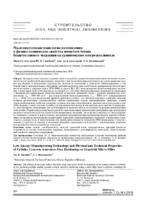| dc.contributor.author | Самуйлов, Ю. Д. | |
| dc.contributor.author | Батяновский, Э. И. | |
| dc.coverage.spatial | Минск | ru |
| dc.date.accessioned | 2024-08-08T07:35:39Z | |
| dc.date.available | 2024-08-08T07:35:39Z | |
| dc.date.issued | 2024 | |
| dc.identifier.citation | Самуйлов, Ю. Д. Малоэнергоемкая технология изготовления и физико-технические свойства ячеистого бетона безавтоклавного твердения на гранитоидном микрозаполнителе = Low-Energy Manufacturing Technology and Physical and Technical Properties of Cellular Concrete Autoclave-Free Hardening on Granitoid Micro-Filler / Ю. Д. Самуйлов, Э. И. Батяновский // Наука и техника. – 2024. – № 4. – С. 304-314. | ru |
| dc.identifier.uri | https://rep.bntu.by/handle/data/147621 | |
| dc.description.abstract | Материал статьи отражает основные этапы и результаты разработки малоэнергоемкой технологии получения ячеистого газобетона безавтоклавного твердения с использованием микрозаполнителя на основе гранитных отсевов для сборного и монолитного строительства, включая ее применение в технологии 3D-бетонирования [1–10]. Разработаны и экспериментально обоснованы: методики расчета состава газобетона по критериям плотности и прочности на сжатие в диапазоне марок D350–D900 и классов B0,5–B7,5 конструкционно-теплоизоляционного назначения, а также марок D100–D300 (прочность на сжатие 0,04–1,50 МПа) теплоизоляционного назначения во взаимосвязи с дисперсностью применяемого микрозаполнителя из молотого гранитного отсева с удельной поверхностью соответственно: Sуд ~ 3000–500 см²/г – для конструкционно-теплоизоляционного, Sуд ~ 30000 см²/г (микрокремнезем) и Sуд ~ 20000 см²/г (ультрадисперсные фракции гранитного отсева) – для теплоизоляционного газобетона; методика контроля реологических (технологических) свойств газобетонных смесей, обеспечивающих требуемые условия структурообразования газобетона расчетных составов; методика оценки бокового давления смеси при укладке в опалубки (формы), а также методика и прибор для неразрушающего контроля как кинетики роста прочности твердеющего, так и прочности затвердевшего или эксплуатируемого ячеистого бетона, полученного по разработанной или иным технологиям. Разработаны режимы беспрогревной и малоэнергоемкой (включающей пропаривание при атмосферном давлении) технологии ячеистого газобетона безавтоклавного твердения, что позволяет отказаться от энергозатратного, технически сложного и дорогостоящего автоклавного оборудования при изготовлении сборных изделий и обеспечивает возможность использования разработанной технологии теплоизоляционного газобетона в монолитном строительстве, включая тепло- и звукоизоляцию стен зданий, выполненных по технологии 3D-бетонирования, а также возведение (устройство) в съемных и несъемных опалубках строительных конструкций с использованием газобетона конструкционно-теплоизоляционного назначения. | ru |
| dc.language.iso | ru | ru |
| dc.publisher | БНТУ | ru |
| dc.title | Малоэнергоемкая технология изготовления и физико-технические свойства ячеистого бетона безавтоклавного твердения на гранитоидном микрозаполнителе | ru |
| dc.title.alternative | Low-Energy Manufacturing Technology and Physical and Technical Properties of Cellular Concrete Autoclave-Free Hardening on Granitoid Micro-Filler | ru |
| dc.type | Article | ru |
| dc.identifier.doi | 10.21122/2227-1031-2024-23-4-304-314 | |
| local.description.annotation | The material in the paper reflects the main stages and results of the development of low-energy-intensive technology for producing cellular aerated concrete without autoclave hardening using a micro-filler based on granite screenings for prefabricated and monolithic construction, including its application in 3D concreting technology [1–10]. The paper has made it possible to develop and experimentally to substantiate: methods for calculating the composition of aerated concrete according to the criteria of density and compressive strength in the range of grades D350–D900 and classes B0.5–B7.5 for structural and thermal insulation purposes, as well as grades D100–D300 (compressive strength 0.04–1.5 MPa) for thermal insulation purposes in conjunction with the dispersion of the applied micro-fillers from ground granite screening with a specific surface area, respectively: Ssp ~ 3000–500 cm2/g for structural and thermal insulation, and for thermal insulation aerated concrete: Ssp ~ 30000 cm2/g (micro-silica) and Ssp ~ 20000 cm2/g (ultra-disperse fractions of granite screenings) – for thermal insulating aerated concrete; methodology for monitoring the rheological (technological) properties of aerated concrete mixtures that provide the required conditions for the structure formation of aerated concrete of calculated compositions, a method for evaluating the lateral pressure of a mixture when laying in formwork (molds), as well as a method and device for non-destructive testing of both the kinetics of strength growth of hardening and the strength of hardened or used cellular concrete, obtained according to the developed or other technology. Modes of non-heating and low-energy (including steaming at atmospheric pressure) technology of cellular aerated concrete of non-autoclave hardening have been developed, which makes it possible to abandon energy-consuming, technically complex and expensive autoclave equipment in the manufacture of prefabricated products and provides the possibility of using the developed technology of thermal insulating aerated concrete in monolithic construction, including heat and sound insulation of the walls of buildings made using 3D concreting technology, as well as the construction (installation) in removable and non-removable formwork of building structures using aerated concrete for structural and thermal insulation purposes. | ru |

